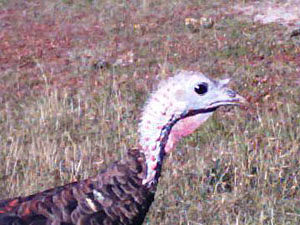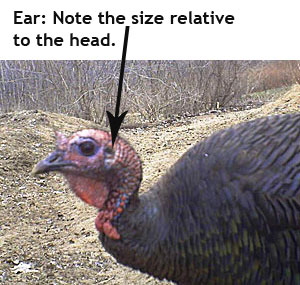The Sixth Sense
By Jim Bulger, Hunter Outreach Program Coordinator
The true turkey hunter cannot just tell you a good story, he/she will tell you a great story and many will include the super powers of a wild turkey. They will spin the tale of the super vision of that wise old Tom who could see the hunter blink his eyes at 100 yards. Or the tale of the Tom with super hearing that could hear the hunter chewing gum and refused to come close enough for a shot. Few other feathered quarry have been elevated to this superhero status. To become a good turkey hunter, you must understand the bird and what ole Tom can really do. Let’s spend a few paragraphs discussing a wild turkey’s senses and how we can best compete with those magical attributes.
Superpower stories aside, the wild turkey does have some amazing senses and they are honed from the time of birth. From the time a poult is born, they quickly develop a keen sense of hearing and sight. They learn from their mothers to fear and run from anything that might harm them; predators from above with wings and on the ground with legs. Survival in the world of a turkey is all about run/hide and if all else fails, fly! A wild turkey is always on the defensive and always alert for danger.
A wild turkey has two senses, sight and hearing, which are probably the most critical for a hunter to understand. Yes, they have the others; taste, touch and smell. Thankfully these are not as highly developed as sight and hearing or a hunter may never harvest a wild turkey. But hearing and sight are the two which will defeat you every time if you do not understand them and how to reduce their effectiveness.
Sight
 A wild turkey has eyes set on the sides of their heads, further back than on a human, allowing them to see about 300 degrees without moving their heads. Their vision is monocular, not binocular so they can see a clear picture of their surroundings all the time. This almost complete circular vision allows the turkey to see in front, to the sides and even behind themselves all the time. The ability to spot even faint movements at over 200 yards can attest to the acuity of their vision. I have stood on the top of a mesa, looking at a flock of turkeys over 300 yards away and have noted they could see me, backlit on the skyline as they beat a hasty retreat in the other direction.
A wild turkey has eyes set on the sides of their heads, further back than on a human, allowing them to see about 300 degrees without moving their heads. Their vision is monocular, not binocular so they can see a clear picture of their surroundings all the time. This almost complete circular vision allows the turkey to see in front, to the sides and even behind themselves all the time. The ability to spot even faint movements at over 200 yards can attest to the acuity of their vision. I have stood on the top of a mesa, looking at a flock of turkeys over 300 yards away and have noted they could see me, backlit on the skyline as they beat a hasty retreat in the other direction.
Fortunately, the monocular vision of a bird deprives them of good depth perception and the ability to judge distance. You can see this when you watch them fly down from a roost or fly up to a limb to roost. They cannot distinguish shapes in detail, a lesson we will visit a bit later in this article. Finally, they have poor night vision so they head to a roost at dusk to prevent nighttime predators from having an evening meal. They will remain on the roost until the next morning when there is enough light to clearly see the dangers around them.
Hearing
 If look at the picture to the right, the arrow points to the ear opening of the hen. With respect to the size of her head, the ear is pretty large and you will note that she does not have any ear flap to channel sounds. The fact that they are such vocal birds indicates they have a highly developed sense of hearing, but it is not a superpower. They use hearing to communicate but they have also adapted it to pick out any unusual sounds that may alert them to danger. The sound of footfalls of a predator in dry leaves, stick breaking under foot or many of the “human” noises we make in the woods can alert the bird to nearby danger.
If look at the picture to the right, the arrow points to the ear opening of the hen. With respect to the size of her head, the ear is pretty large and you will note that she does not have any ear flap to channel sounds. The fact that they are such vocal birds indicates they have a highly developed sense of hearing, but it is not a superpower. They use hearing to communicate but they have also adapted it to pick out any unusual sounds that may alert them to danger. The sound of footfalls of a predator in dry leaves, stick breaking under foot or many of the “human” noises we make in the woods can alert the bird to nearby danger.Kryptonite
Understanding how the birds use these senses to avoid danger can be the best tool in a turkey hunter’s tool kit. A few tips can help you become a better hunter this spring.
Sight: Wear camouflage clothing that blends in with the natural surroundings. Cover your head, face and hands. Avoid wearing any bright colors which may bring attention to you, especially reds, whites and blue colors from both a concealment aspect and safety in the woods aspect as well.
Sight: Do not make any fast movements in the woods, when walking, move slowly, looking as far ahead as you can see. When sitting, all movements must be “cold molasses” slow! When setting up near a roost site, set up in the dark, at least 30 minutes before first light – not sunrise!
Sight: If you use decoys, set them so the Tom can see them at an angle away from where you plan to sit. Look at how you think the bird will approach so you are not in a direct line of sight with the decoy.
Sight: If you have a bird within range, only move when the bird is facing directly away from you or his head is behind a tree or other structure. When a tom is strutting with a full tail fan, if the fan is between you and the bird’s head, you can move.
Hearing: Keep all noise to a minimum in the woods. Do not slam car doors when leaving for the roost sight, even if it is ½ mile away. Talk in whispers, band your box calls so they do not make a noise when you walk.
Hearing: Remove dead leaves, limbs and such when you choose a place to sit so you are not making noises if you move when sitting.
Hearing: Take your snacks out of the noisy paper wrappers and put them in a Ziploc bag before the hunt.
Wear “soft” clothing in the woods that will not make sounds when you are walking or scraping against weeds or branches.
Epilogue
No, they do not have superpowers, but they are pretty good. I titled this article as the “Sixth Sense” because I think the wild turkey does have that uncanny ability to “feel” when something is just not right, when his back feathers stand up for an unexplained reason and he decides to take a different path than the one I thought he would take.
I am pretty sure that wise old tom I missed last year saw me blink at 100 yards..that’s my story and I’m sticking to it.

